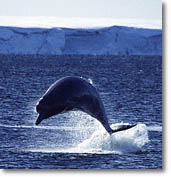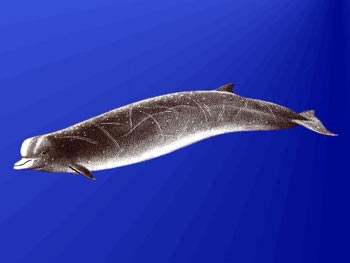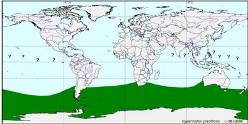9870 St Vincent Place, Glasgow, DC 45 Fr 45.
Вид: Hyperoodon planifrons = Плосколобый бутылконос

- Класс: Mammalia Linnaeus, 1758 = Млекопитающие
- Инфракласс:Eutheria, Placentalia Gill, 1872 = Плацентарные, высшие звери
- Отряд: Cetacea Brisson, 1762 = Китообразные
- Подотряд: Odontoceti Flower, 1867 = Зубатые киты
- Семейство: Ziphiidae Gray, 1865 =
- Род: Hyperoodon Lacepede, 1804 = Бутылконосы
- Вид: Hyperoodon planifrons Flower, 1882 = Плосколобый бутылконос
Вид: Hyperoodon planifrons Flower, 1882 = Плосколобый бутылконос

Распространен в южном полушарии от льдов Антарктики, Южной Георгии, Южных Оркнейских и Фолклендских островов до широты Австралии, Новой Зеландии и Аргентины. Его челюстные гребни и "лоб" ниже, а клюв короче, чем у высоколобого бутылконоса.
1. Description
Bottlenose whales are relatively large beaked whales and reach 6 - 9 m body length. Their body shape is robust and they have a large, bulbous-shaped forehead and short, dolphin-like beak. Their colour is chocolate brown to yellow, being lighter on the flanks and belly. This coloration is believed to be caused by a thin layer of phytoplankton, diatoms. Mature males have a squared-off forehead, whereas in females and immature males it is rounded. Males possess a single pair of conical teeth at the tip of the lower jaw, rarely visible in live animals (Gowans 2002).
2. Distribution
Southern bottlenose whales are thought to have a circumpolar distribution in the Southern Hemisphere, south of 29°S (Mead, 1989; Jefferson et al. 1993) and to cover a wider range than their northern counterparts (Carwardine, 1995). They occur from Rio Grande do Sul in Brazil, Cape Province in South Africa, 31°S in the western Indian Ocean, Dampier Archipelago in Western Australia, Ulladulla in New South Wales, North Island in New Zealand, and Valparaiso in Chile, south to the Antarctic continent (Rice, 1998).
Distribution of Hyperoodon planifrons (mod. from Jefferson et al. 1993; © CMS / GROMS):
The species inhabits the cold, deep waters of the southern hemisphere from Antarctica 
North to at least 29°S (Carwardine, 1995). Enlarge map
Possible sightings south of Japan, around Hawaii, and along the equator (in the Pacific and Indian Oceans) have not been identified with certainty, but may be discrete populations of this species (Carwardine, 1995; Jefferson et al. 1993).
The records from north-western Australia and from Brazil indicate that H. planifrons also occurs in warm temperate waters. It makes plausible the identification of a beaked whale that has been observed in the eastern equatorial Pacific as this species. There have been several reports of a species of Hyperoodon in the North Pacific but so far all incidents could be attributed to Berardius bairdii (Mead, 1989 and refs. therein). Recent molecular work indicates that there may be more than one species (Dalebout et al. 1998). Pitman et al. (1999) suggested that the tropical bottlenose whale is actually Logman's beaked whale Indopacetus pacificus, known hitherto only from skeletal remains.
3. Population size
Mead (1989) reported that there are no population estimates or even rough figures on relative abundance of Hyperoodon planifrons. In 1995, Kasamatsu and Joyce (1995) published abundance estimates for south of the Antarctic Convergence in January: 599,300 beaked whales, most of which were southern bottlenose whales.
4. Biology and Behaviour
Habitat: H. planifrons is most common beyond the continental shelf and over submarine canyons, in water deeper than 1,000m. It is rarely found in water less than 200m deep. In summer, this species is most frequently seen within about 100km of the Antarctic ice edge, where it appears to be relatively common (Carwardine, 1995). Cockroft et al. (1990) report sightings in the steep thermocline between the Agulhas current and cold Antarctic water masses.
Behaviour. The Southern Bottlenose Whale is poorly known and rarely observed at sea. It lives far from shipping lanes, and has never been heavily exploited, so it has not been as well studied as its northern counterpart. There are few reports of swimming near boats, but this may be due to lack of observation rather than shyness. After long dives, it may remain on the surface for 10 minutes or more, blowing every 30 to 40 seconds. It can stay underwater for at least an hour, but typical dive time is shorter. When swimming fast, especially under stress, it may raise its head clear of water on surfacing. Probably a deep diver, though it does not tend to travel much horizontal distance while submerged (Carwardine, 1995). There is essentially nothing known of the reproductive biology of this species (Jefferson et al. 1993).
Schooling: Pods of less than 10 are most common, but groups of up to 25 have been seen (Jefferson et al. 1993).
Food. Southern bottlenose whales are thought to take primarily squid, but probably they also eat fish and possibly squid (Jefferson et al. 1993; Slip et al. 1995; Clarke and Goodall, 1994). Consumption of food (mostly squid) by all Odontocetes south of the Antarctic convergence was estimated as 14.4 million tonnes with 67% of the total consumed by beaked whales. Odontocetes, especially southern bottlenose whales, are suggested to have a much greater role in the Antarctic ecosystem than has previously been considered (Kasamatsu and Joyce, 1995). For details on beaked whale diet and niche separation see also the account on Mesoplodont whales.
5. Migration
Southern bottlenose whales apparently migrate, and are found in Antarctic waters during the summer. Like other beaked whales, they are deep-water oceanic animals (Jefferson et al. 1993). Kasamatsu and Joyce (1995) investigated the spatial distribution of various cetacean species during mid-summer in Antarctic waters and found different peaks of occurrence for each species by latitude, suggesting possible segregation. Killer whales occur mainly in the very southernmost areas, sperm whales in the southern half of the study area, whereas beaked whales (mostly southern bottlenose whales Hyperoodon planifrons) ranged over a wide area.
Sekiguchi et al. (1993) investigated the stomach contents of 2 southern bottlenose whales, a male caught off the east coast, and a female stranded alive on the west coast of South Africa, respectively. Both stomachs contained only remains of oceanic squid species, with four Antarctic and 4 subantarctic squid species present. Sightings of southern bottlenose whales off Durban between February and October showed strong seasonality with peaks in February and October. The beaks of Antarctic and subantarctic squids in the stomachs, plus the presence of cold water skin diatoms Bennettella (= Cocconeis) ceticola on the male, suggest that the animals had arrived comparatively recently in South African waters from higher latitudes.
http://www.cms.int/reports/small_cetaceans/data/H_planifrons/h_planifrons.htm
